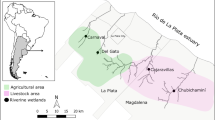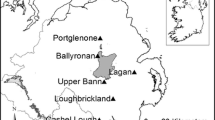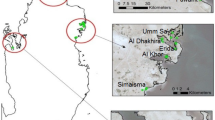Abstract
One of the most serious threats to tropical mangrove ecosystems caused by shrimp farming activities is the poor management of pond waste materials. We hypothesise that mangroves can tolerate chemical residues discharged from shrimp farms and can be used as biofilters, but the capability of mangroves to cope with solid sediments dredged from shrimp ponds is limited. Our study in Pak Phanang, Thailand, confirmed that the excess sediments discharged from nearby shrimp ponds reduced mangrove growth rates and increased mortality rates. A series of transformed multi-temporal satellite images was used in combination with the field data to support this claim. In addition, a comparison between four dominant mangrove species revealed that Avicennia marina could tolerate sedimentation rates of >6 cm year−1, while Bruguiera cylindrica tolerated sedimentation rates of 5 cm year−1 (total sediment depth = 25 cm) before dying, while Excoecaria agallocha and Lumnitzera racemosa performed intermediate. This outcome implied that in our situation A. marina and to lesser extent E. agallocha and L. racemosa could be more effective as biofilters than B. cylindrica, as they may survive the sedimentation longer in the disposal areas. Further studies on the impact of sedimentation and chemical pollution of shrimp farm wastes on mangrove mortality and growth are required.







Similar content being viewed by others
References
Atmadja, W. S. & Soerojo, 1994. Mangrove status of Indonesia. In: Wilkinson C., S. Sudara & C. L. Ming (eds), Proceedings Third ASEAN-Australia Symposium on Living Coastal Resources. Australian Institute of Marine Science, Townsville: 201–207.
Barbier, E. B. & S. Sathiratai, 2004. Shrimp Farming and Mangrove Loss in Thailand. Edward Elgar Publishers, Cheltenham.
Boyd, C. E., 2003. Guidelines for aquaculture effluent management at the farm level. Aquaculture 226: 101–112.
Boyd, C. E. & L. Massaut, 1999. Risks associated with the use of chemicals in pond aquaculture. Aquacultural Engineering 20: 113–132.
Boyd, C. E. & Y. Musig, 1992. Shrimp pond effluents: observations of the nature of the problem on commercial farms. In Wyban, J. A. (ed.), Proceedings of the Special Sessions on Shrimp Farming. World Aquaculture Society, Baton Rouge: 195−197.
Briggs, M. R. P. & S. J. Funge-Smith, 1994. A nutrient budget of some intensive marine shrimp ponds in Thailand. Aquaculture and Fisheries Management 25: 789–811.
Chu, H. Y., N. C. Chen, M. C. Yeung, N. F. Y. Tam & Y. S. Wong, 1998. Tide-tank system simulating mangrove wetland for removal of nutrients and heavy metals from wastewater. Water Science and Technology 38: 361–368.
CORIN institute, 1991. Coastal Management in Pak Phanang: A Historical Perspective of the Resources and Issues. Prince of Songkla University, Songkla.
Das, B., Y. S. A. Khan & P. Das, 2004. Environmental impact of aquaculture-sedimentation and nutrient loadings from shrimp culture of the southeast coastal region of the Bay of Bengal. Journal of Environmental Sciences 16: 466–470.
Ellison, J. C., 1998. Impacts of sediment burial on mangroves. Marine Pollution Bulletin 37: 420–426.
Erler, D., P. C. Pollard & W. Knibb, 2004. Effects of secondary crops on bacterial growth and nitrogen removal in shrimp farm effluent treatment systems. Aquacultural Engineering 30: 103–114.
Gautier, D., J. Amador & F. Newmark, 2001. The use of mangrove wetland as a biofilter to treat shrimp pond effluents: preliminary results of an experiment on the Caribbean coast of Colombia. Aquaculture Research 32: 787–799.
Gräslund, S., K. Holmström & A. Wahlström, 2003. A field survey of chemicals and biological products used in shrimp farming. Marine Pollution Bulletin 46: 81–90.
Halling-Sørensen, B., 2000. Algal toxicity of antibacterial agents used in intensive farming. Chemosphere 40: 731–739.
Halling-Sørensen, B., S. Nors Nielsen, P. F. Lanzky, F. Ingerslev, H. C. Lützhøft & S. E. Jørgensen, 1998. Occurence, fate and effects of pharmaceuticals in the environment – A review. Chemosphere 36: 357–393.
Halling-Sørensen, B., H. C. Holten Lützhøft, H. R. Andersen & F. Ingerslev, 2000. Environmental risk assessment of antibiotics: comparison of mecillinam, trimethoprim and ciprofloxacin. Journal of Antimicrobial Chemotherapy 46: 53–58.
Holten Lützhøft, H. C., B. Halling-Sørensen & S. E. Jørgensen, 1999. Algal toxicity of antibacterial agents applied in Danish fish farming. Archives of Environmental Contamination and Toxicology 36: 1–6.
Huitric, M., C. Folke & N. Kautsky, 2002. Development and government policies of the shrimp farming industry in Thailand in relation to mangrove ecosystems. Ecological Economics 40: 441–455.
Hydrographic Department, 1996. Tide table, Royal Thai Navy, Bangkok.
Jensen, J. R., 2006. Remote Sensing of the Environment. Prentice Hall, New Jersey.
Joshi, H. & M. Ghose, 2003. Forest structure and species distribution along soil salinity and pH gradient in mangrove swamps of the Sundarbans. Journal of Tropical Ecology 44: 195–204.
Lillesand, T. M. & R. W. Kiefer, 2000. Remote Sensing and Image Interpretation. John Wiley & Sons, New York.
Lugo, A. E. & G. Cintrón, 1975. The mangrove forests of Puerto Rico and their management. In Walsh, G., S. Snedaker & H. Teas (eds), Proceedings of International Symposium on Biology and Management of Mangroves. Institute of Food and Agricultural Sciences, University of Florida, Gainesville: 825–846.
MacFarlane, G. R. & M. D. Burchett, 2002. Toxicity, growth and accumulation relationships of copper, lead and zinc in the grey mangrove Avicennia marina (Forsk.) Vierh. Marine Environmental Research 54: 65–84.
Massaut, L., 1999. Mangrove Management and Shrimp Aquaculture, Research and Development Series No. 44. Auburn University, Alabama.
Naylor, R., R. Goldburg, H. Mooney, M. Beveridge, J. Clay, C. Folke, N. Kautsky, J. Lubchenco, J. Primavera & M. Williams, 1998. Nature’s subsidies to shrimp and salmon farming. Science 282: 883–884.
Peters, E. C., N. J. Gassman, J. C. Firman, R. H. Richmond & E. A. Power, 1997. A Ecotoxicology of tropical marine ecosystems. Environmental Toxicology and Chemistry 16: 12–40.
Ohimain, E. I., W. Andriesse & M. E. F. van Mensvoort, 2004. Environmental impacts of abandoned dredged soils and sediments: available options for their handling, restoration and rehabilitation. Journal of Soils and Sediments 4: 59–65.
Rivera-Monroy, V. H., L. A. Torres, N. Bahamon, F. Newmark & R. R. Twilley, 1999. The potential use of mangrove forests as nitrogen sinks of shrimp aquaculture pond effluents: The role of denitrification. Journal of the World Aquaculture Society 30: 12–25.
Robertson, A. I. & M. J. Phillips, 1995. Mangroves as filters of shrimp pond effluent: predictions and biogeochemical research needs. Hydrobiologia 295: 311–321.
Sansanayuth, P., A. Phadungchep, S. Ngammontha, S. Ngdngam, P. Sukasem, H. Hoshino & M. S. Ttabucanon, 1996. Shrimp pond effluent: pollution problems and treatment by constructed wetlands. Water Science and Technology 34: 93–98.
Satapornvanit, K., 1993. The environmental aspects of shrimp farm effluent. Masters Thesis, Asian Institute of Technology, Bangkok, Thailand.
Tam, N. F. Y. & Y. S. Wong, 1995. Spatial and temporal variations of heavy metal contamination in sediments of a mangrove swamp in Hong Kong. Marine Pollution Bulletin 31: 254–261.
Terrados, J., U. Thampanya, N. Srichai, P. Kheowvongsri, O. Geertz-Hansen, S. Boromthanarath, N. Panapitukkul & C. M. Duarte, 1997. The effect of increased sediment accretion on the survival and growth of Rhizophora apiculata seedlings. Estuarine, Coastal and Shelf Science 45: 697–701.
Thom, B. G., 1967. Mangrove ecology and deltaic geomorphology: Tabasco, Mexico. Journal of Ecology 55: 301–343.
Tookwinas, S., 1996. Environmental Impact Assessment in Intensive Marine Shrimp Farming in Thailand. Coastal Aquaculture Division, Department of Fisheries, Bangkok.
Twilley, R. R., R. H. Chen & T. Hargis, 1992. Carbon sinks in mangroves and their implications to carbon budget of tropical coastal ecosystems. Water, Air, and Soil Pollution 64: 265–288.
West, R. C., 1956. Mangrove swamps of the pacific coast of Colombia. Association of American Geographers Annals 46: 98–121.
Wollenberger, L., B. Halling-Sørensen & K. O. Kusk, 2000. Acute and chronic toxicity of veterinary antibiotics to Daphnia magna. Chemosphere 40: 723–730.
Acknowledgements
We would like to thank Dr. Darasri Dowreang and staffs of GISTDA, Thailand for the Landsat images of the study area, and the editors and reviewers for their valuable comments. Lastly, we thank the Faculty of Engineering, Chulalongkorn University for their financial support.
Author information
Authors and Affiliations
Corresponding author
Rights and permissions
About this article
Cite this article
Vaiphasa, C., de Boer, W.F., Skidmore, A.K. et al. Impact of solid shrimp pond waste materials on mangrove growth and mortality: a case study from Pak Phanang, Thailand. Hydrobiologia 591, 47–57 (2007). https://doi.org/10.1007/s10750-007-0783-6
Issue Date:
DOI: https://doi.org/10.1007/s10750-007-0783-6




